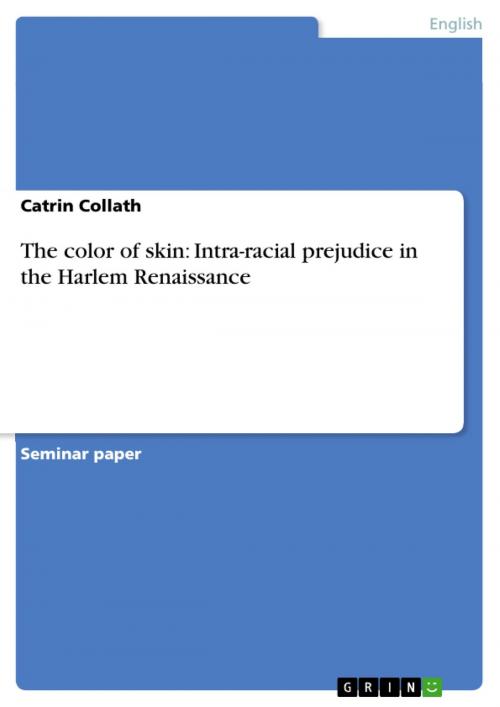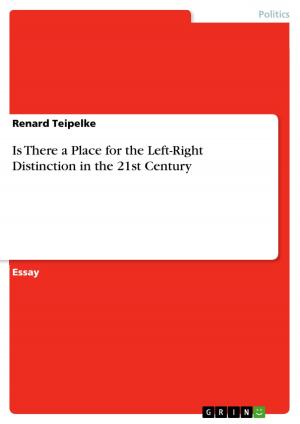The color of skin: Intra-racial prejudice in the Harlem Renaissance
Nonfiction, Entertainment, Drama, Anthologies| Author: | Catrin Collath | ISBN: | 9783638110709 |
| Publisher: | GRIN Publishing | Publication: | January 28, 2002 |
| Imprint: | GRIN Publishing | Language: | English |
| Author: | Catrin Collath |
| ISBN: | 9783638110709 |
| Publisher: | GRIN Publishing |
| Publication: | January 28, 2002 |
| Imprint: | GRIN Publishing |
| Language: | English |
Seminar paper from the year 2002 in the subject American Studies - Literature, grade: 1- (A-), University of Hamburg (Institute for english language and culture), course: Seminar II: Neither Black Nor White-Yet Both: Miscegenation and Passing in Interracial Literature, 12 entries in the bibliography, language: English, abstract: Introduction THERE! That's the kind I've been wanting to show you! One of the best examples of the specie. Not like those diluted Negroes you see so much of on the streets these days, but the real thing. Black, ugly, and odd. You can see the savagery. The blunt blankness. That is the real thing. (Gwendolyn Brooks)(1) It is not only Lincoln in Gwendolyn Brooks's poem (1970) who is regarded as ugly because of his pronounced black features. In Wallace Thurman's novel The Blacker the Berry the protagonist also experiences different forms of intra-racial prejudice. Like Lincoln, Emma Lou is regarded as 'the real thing [-] black, ugly and odd.' This is at least how she feels and how she sees herself, always observing herself through the eyes of others. To give a brief introduction to the topic of intra-racial prejudice, Brooks's poem was chosen to support the fact that people are prejudiced against other people; even though they belong to the same race. Although the utterance about Lincoln is made by a white man in a movie theater, it cannot be denied that those racist remarks also occur among people who are perceived to belong to one and the same race. Either way, Lincoln is regarded as being the ugliest boy that everyone ever saw. And this is exactly how Emma Lou feels. She supports the misconception of the white man at the movie theater and of society's stereotypes that dark-skinned blacks do not know as much as light-skinned blacks and therefore are considered to be inferior. The author already makes a distinction between dark-skinned African Americans and not that dark-skinned African Americans when he compares the 'real thing' black person with 'those diluted Negroes you see so much of on the streets these days'. With this phrase she covers one of the major topics in Wallace Thurman's novel which is about prejudice within one race. The protagonist is always aware of her color which is a result of her sstruggle with the society and herself and it will be described on several examples in the novel. [...] ______ 1 http://www2.gasou.edu.
Seminar paper from the year 2002 in the subject American Studies - Literature, grade: 1- (A-), University of Hamburg (Institute for english language and culture), course: Seminar II: Neither Black Nor White-Yet Both: Miscegenation and Passing in Interracial Literature, 12 entries in the bibliography, language: English, abstract: Introduction THERE! That's the kind I've been wanting to show you! One of the best examples of the specie. Not like those diluted Negroes you see so much of on the streets these days, but the real thing. Black, ugly, and odd. You can see the savagery. The blunt blankness. That is the real thing. (Gwendolyn Brooks)(1) It is not only Lincoln in Gwendolyn Brooks's poem (1970) who is regarded as ugly because of his pronounced black features. In Wallace Thurman's novel The Blacker the Berry the protagonist also experiences different forms of intra-racial prejudice. Like Lincoln, Emma Lou is regarded as 'the real thing [-] black, ugly and odd.' This is at least how she feels and how she sees herself, always observing herself through the eyes of others. To give a brief introduction to the topic of intra-racial prejudice, Brooks's poem was chosen to support the fact that people are prejudiced against other people; even though they belong to the same race. Although the utterance about Lincoln is made by a white man in a movie theater, it cannot be denied that those racist remarks also occur among people who are perceived to belong to one and the same race. Either way, Lincoln is regarded as being the ugliest boy that everyone ever saw. And this is exactly how Emma Lou feels. She supports the misconception of the white man at the movie theater and of society's stereotypes that dark-skinned blacks do not know as much as light-skinned blacks and therefore are considered to be inferior. The author already makes a distinction between dark-skinned African Americans and not that dark-skinned African Americans when he compares the 'real thing' black person with 'those diluted Negroes you see so much of on the streets these days'. With this phrase she covers one of the major topics in Wallace Thurman's novel which is about prejudice within one race. The protagonist is always aware of her color which is a result of her sstruggle with the society and herself and it will be described on several examples in the novel. [...] ______ 1 http://www2.gasou.edu.















